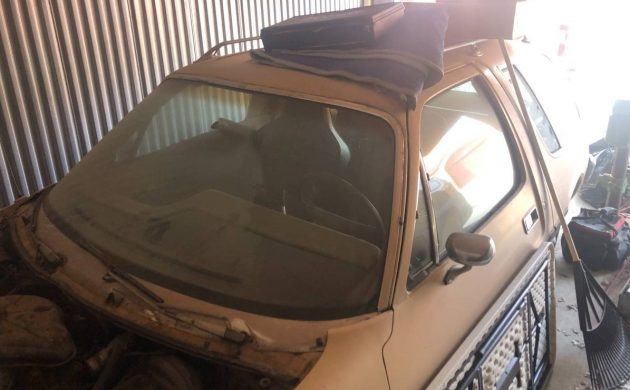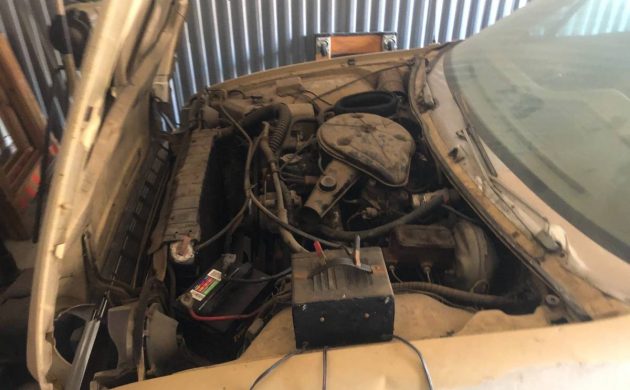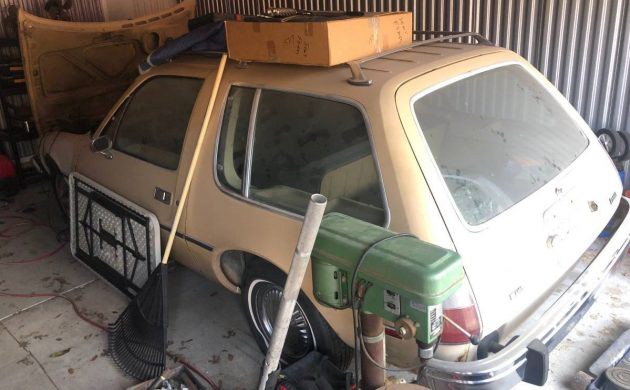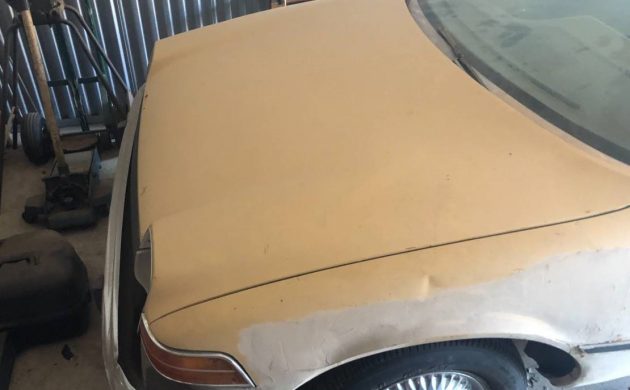American Motors was always trying to play catch-up to the Detroit “Big 3”. So, when it came time to come up with a new compact to do battle in a fiercely competitive market, they rolled the dice in the mid-1970s and introduced the Pacer. It was quite different in appearance than what the others were offering, as wide as any Cadillac and with glass comprising more than a third of the space the car occupied. This “bathtub on wheels” (among other nicknames) is from 1977 and looks to have been parked in a storage space for the past decade. It’s available in Round Rock, Texas, and here on craigslist for $3,000. Another great tip from Pat L.!
When the idea for the Pacer first surfaced, it was called Project Amigo. It was conceived as the industry’s “first wide small car” and AMC experimented with various designs and technology, such as a Wankel rotary engine that eventually was deemed too costly. The end result was an odd-looking automobile with rack & pinion steering, independent front suspension, and a huge glass area for good visibility everywhere you looked. And it used inline-6 engines that were already part of AMC’s inventory.
Initially available with either 232 or 258 cubic inch I-6 motors, the cars were underpowered for their girth and weight. One of those powerplants is in the seller’s wagon, paired with an automatic transmission. AMC’s small-block V8 would come a little later to thwart concerns about power, but then this was supposed to be an economy car so did that defeat the purpose? AMC built 280,000 Pacers over a six-year production run from 1975-80. Most of them were the bubble-shaped sedans made famous in the Wayne’s World movies.
This ’77 wagon has been laid up in storage for at least 10 years and is beginning to become surrounded by other stuff that you would put away and forget about. Though the photos don’t show the car doing anything but sitting still, we’re told it starts and runs but not how well. The odometer reading is likely to be 129,000 as the dial has already turned over.
Other than some little dents and dings, the body looks good but at least one tire is flat. The struts in the hatchback have been replaced and the expansive glass is good. The Pacer is going to need some new tires. If you’ve ever had a yen for one of these rolling aquariums, this might be a decent starting point.







The Wankel rotary engine wasn’t abandoned due to cost, but because planned supplier GM backed out of their rotary development project at the last minute due to concerns with emissions and fuel economy.
This left AMC holding the bag, having bet the farm on a car planned around an engine that didn’t exist. Additionally, AMC had sold the compact V6 that came with with their Jeep acquisition back to GM where it originated, so they had little choice but to shoehorn in their inline six, with the back cylinders protruding into the passenger space via a large bulge in the firewall.
Also the Pacer was not originally meant to be as wide and heavy as it turned out. Concerns about possible upcoming safety regulations found the company bulking up the design to meet anything they could envision since they would not be able to afford redesigning the car. This turned the Pacer design from a lightweight, fleet coupe into the heavy, slow, gas-thirsty fishbowl we’ve come to know and love. (It also made the Pacer one of the safest cars from that time period.)
Correct on both counts. I often wonder what would have happened if GM had followed through and supplied its Wankel engine to AMC. In spite of its 3.4 liters (Mazda’s RX-8 used a 1.3L Wankel), the engine only produced 125 lb-ft of torque. Even without the extra safety equipment, performance would have been weak. Throw in the Wankel’s generally poor fuel economy and apex seal issues, and AMC’s sixes start to look like the better idea.
I have no doubt that the GM Wankel would have been a disaster, at least Pacers were mechanically reliable. The real shame is that the Jeep V6 would have fit much better than the inline six in the Pacer’s short engine compartment. Of course that engine was kind of rough-running, being basically 3/4 of an early 1960s Buick Special 215 V8, cast in iron instead of aluminum, which resulted in a 90 degree “V” and odd firing impulses.
AMC stopped production of the V6 in 1971 and sold the tooling back to GM in 1974.
@CCFisher, right forgot to mention that. GM first approached AMC about buying complete V6 engines but AMC balked at that and wound up selling them back all the tooling.
GM achieved an outstanding 750’00 km life for their Wankel, but said were unable to achieve both economy and emissions goals in same design. Wkipedia has interesting info about Wankel, and GM Wankel.
Perhaps the Pacer was so wide because it was designed also to have Front Wheel Drive, when return to rear Axle was forced, the body was widened to provide room for transmission, a Chrysler torqueflite in the automatic versions.
The AMC 6L, its last development was the Jeep 4.0 HO engine, with the head and intake-exhaust system, EFI from the Jeep, the AMC 6L gains 40 HP, improves economy en 3 litres/ 100 km less, is a heavy, tractor-like power engine, 110 HP in the 4.2 litres version.
AMC installed in Gremlin a 2 litre, 4 cylinder Audi engine; just from this, engine weight was reduced in over 100 kg, some European AMC fans installed a Chrysler 2L engine in their AMC, automatic transmission is same.
Pacers are agile and fun to drive if wheel alignment and tire pressures are within specs. No experience at high speeds is easily available; with standard equipment, top speed was somehow below 99 mph, with the rigid and blade controlled rear axle, this is not a high speed combination.
The Mazda 4 port Renesis engine in RX-8, there are also 6 port versions, offered 192 HP at 7000 rpm; 198 NM at 5’000 rpm; this is best compared to a 2608 cc reciprocating engine, considering displacement as two chambers per rotor.
Figures for 232 Pacer are 90 HP at 3050 rpm, 231 NM at 2000 rpm; for 4.2 litres engine,100 HP and 244 NM at same rpm, but this can be irmpoved just with an aftermarket camshaft..
You could make install any 13B Mazda RC Engine in the Pacer, and compare, it’s not impossible nor extremely expensive.
The Pacer would admit other engines, as the Corvair 6-Flat, reverse turning camshafts are offered, there were versions of this engine with more than 140 HP, with a turbo,…
Blessings +
GM achieved an outstanding 750’000 km life for their Wankel, but said were unable to achieve both economy and emissions goals in same design. Wkipedia has interesting info about Wankel, and GM Wankel.
Perhaps the Pacer was so wide because it was designed also to have Front Wheel Drive, when return to rear Axle was forced, the body was widened to provide room for transmission, a Chrysler torqueflite in the automatic versions.
The AMC 6L, its last development was the Jeep 4.0 HO engine, with the head and intake-exhaust system, EFI from the Jeep, the AMC 6L gains 40 HP, improves economy en 3 litres/ 100 km less, is a heavy, tractor-like power engine, 110 HP in the 4.2 litres version.
AMC installed in Gremlin a 2 litre, 4 cylinder Audi engine; just from this, engine weight was reduced in over 100 kg, some European AMC fans installed a Chrysler 2L engine in their AMC, automatic transmission is same.
Pacers are agile and fun to drive if wheel alignment and tire pressures are within specs. No experience at high speeds is easily available; with standard equipment, top speed was somehow below 99 mph, with the rigid and blade controlled rear axle, this is not a high speed combination.
The Mazda 4 port Renesis engine in RX-8, there are also 6 port versions, offered 192 HP at 7000 rpm; 198 NM at 5’000 rpm; this is best compared to a 2608 cc reciprocating engine, considering displacement as two chambers per rotor.
Figures for 232 Pacer are 90 HP at 3050 rpm, 231 NM at 2000 rpm; for 4.2 litres engine,100 HP and 244 NM at same rpm, but this can be irmpoved just with an aftermarket camshaft..
You could make install any 13B Mazda RC Engine in the Pacer, and compare, it’s not impossible nor extremely expensive.
The Pacer would admit other engines, as the Corvair 6-Flat, reverse turning camshafts are offered, there were versions of this engine with more than 140 HP, with a turbo,…
Blessings +
Nice looking car. I’d buy a 1977 Pacer if it was in nicer condition. I’ve always found the wagon version way better looking than the sedan. Given its age and condition, I’d pay close to the $3,000 asking price. You can still upgrade a few things while you restore it.
Curious about the interior…probably vinyl as opposed to the funky Navajo fabric
Sales of RX-8 were discontinued in Europe from not fulfilling the emissions standards, but this was only in the CO2 per km, 258 gr/ km in the 4 port Renesis II, because this was too much CO2 for an engine rated as 1308 cc, probably situation would have bot been same if the displacement of 2616 cc was considered. Blessings +
w/carnut on this 1: waggy, 3K$ But…
I’d love to daily it esp w/the 4.2, no hood bump and the last bolt
(so I was told bya car upholstry place) of one of the ‘navajo” ‘fabrics”.,
I’ve seen 2 to 4 MPGs difference between some i6 v bent8 motors.
We dont buy these for MPGs. A tinkerer can get special performance –
wrd means that (MPGs) AND pep but often it is not exotic. That must be obtained by focus in motor engineering addeded to (like any system 1 thing wont ‘get it’, 100s of smaller 1s will) body design, tires, etc, etc & driver input~
Conway Twitty drove a Pacer,p- magnet edition.